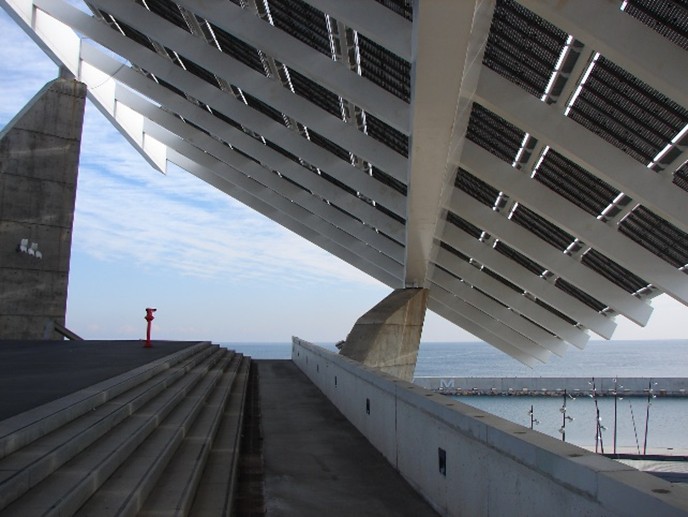Topography and urban furniture: adaptation strategies in contemporary public spaces
DOI:
https://doi.org/10.37636/recit.v8n1e411Keywords:
Topography, Urban furniture, Public space, BarcelonaAbstract
The research aims to establish a theoretical and analytical framework for integrating urban furniture with topography in public space design. Through the analysis of emblematic cases, strategies that have successfully adapted terrain slopes to create functional and socially active spaces are identified. This study highlights three key design principles: the use of terrain slopes as structuring elements, the multifunctionality of seating areas, and the reduction of earthworks to minimize environmental impact. The article examines the evolution of these strategies with a particular focus on Barcelona, a city where topographic adaptation has played a crucial role in shaping public space. The selection of case studies is based on both the urban and academic significance of these spaces and the author's direct experience, as they explored and analyzed their functionality while conducting doctoral studies in the city. Emblematic cases such as Park Güell and projects from the Fórum Barcelona are examined, demonstrating how design can enhance user experience and reinforce place identity. The criteria applicable to current urban design are established by studying historical and contemporary examples in Barcelona. Finally, the study underscores the importance of considering the relationship between topography and urban furniture as a fundamental axis in urban planning, aiming to develop strategies that optimize public space quality and foster more livable and dynamic environments.
Downloads
References
C. Alexander, S. Ishikawa y M. Silverstein. A Pattern Language: Towns, Buildings, Construction. Oxford: Oxford University Press, 1977.
R. Moneo. Inquietud teórica y estrategia proyectual en la obra de ocho arquitectos contemporáneos.Barcelona: Actar, 2004.
J. Gehl. Life Between Buildings: Using Public Space. Washington: Island Press, 2011.
M. Vitruvio. Los diez libros de arquitectura (J. L. Oliver Domingo, Trad.). Madrid: Alianza Editoria, 2015.
A. Duany y J. Speck. The Smart Growth Manual. New York: Mc Graw Hill, 2010.
Pioneer Valley Planning Commission, «Smart growth toolkit: a guide to community strategies for better growth & development,» 2003. [En línea]. Available: https://www.pvpc.org/sites/default/files/files/Smart%20Growth-Full%20Toolkit.pdf.
M. Van den Berg, W. Wendel-Vos y et al, «Health Benefits of Green Spaces in Cities,» Journal of Urban Health, vol. 97, nº 4, p. 461–472.
J. Gehl. Cities for people. Washington: Island Press, 2010.
S. Lehmann. Sustainable urbanism: reimagining cities for the future. Routledge, 2019.
L. Groat y D. Wang. Architectural research methods. New York: John Wiley & Sons, 2013.
J. Rivera Linares, «El parque de la España Industrial o el elogio del graderío,» Paisea, nº 15, pp. 70-76, 2010.
C. Norberg-Schulz. Genius Loci: towards a Phenomenology of Architecture. New York: Rizzoli International Publications, 1980.
N. Roberts, «La Défense: From Axial Hierarchy to Open System,» de 99th ACSA Annual Meeting Proceedings, 2011.
M. Reigelman, «markreigelman.com,» agosto 2007. [En línea]. Available: http://www.markreigelman.com/.
«Arquitectura Viva,» [En línea]. Available: https://arquitecturaviva.com/obras/parque-de-los-auditorios-barcelona. [Último acceso: Febrero 2025].
L. Peña Ganchegui. «www.ganchegui.com,» [En línea]. Available: https://www.ganchegui.com/munibe/biblio/biblio.htm.
MBM Arquitectos. MBM Arquitectos:1951-2000. Barcelona: Gustavo Gili, 2000.
J. Martínez Lapeña y E. Torres Tur, «Forum 2004: Barcelona,» Arquitectura Viva, vol. 96, pp. 34-41, 2004.
M. Crippa. Gaudí. Colonia: Taschen, 2007.
Y. F. Tuan. Space and Place: The Perspective of Experience. Minneapolis: University of Minnesota Press., 1977.
Ajuntament de Barcelona / MUHBA. El Park Güell i els seus orígens, 1894-1926. Barcelona: Ajuntament de Barcelona, 2019.
L. Permanyer. Barcelona modernismo a modernidad. Barcelona: Ediciones Polígrafa, 1991.
W. Heywood. Nostra Donna d'Agosto e il Palio di Siena. Siena: Protagon Editori Toscani, 1993.
B. Gómez-Pimienta, «Arquine,» 2023. [En línea]. Available: https://arquine.com/el-primer-museo-contemporaneo-cumple-40-anos/
Arriola & Fioli Arquitectes, «Arquitectura catalana,» [En línea]. Available: https://www.arquitecturacatalana.cat/es/obras/placa-al-fossar-de-les-moreres#anchor2.
J. Antón y C. Serra, «Entrevista:Albert Viaplana. Arquitecto y autor de la reforma de la plaza de Lesseps,» El país, 17 11 2008.
P. Reed. Groundswell: constructing the contemporary landscape. New York: The Museum Of Modern Art, 2005.
D. Langdon, «Archdaily,» 2014. [En línea]. Available: https://www.archdaily.com/554132/ad-classics-yokohama-international-passenger-terminal-foreign-office-architects-foa.
B. Gali y J. Benavent, «Zona de banys,» Quaderns d'arquitectura i urbanisme, nº 240, p. 121, 2004.
F. Stevenson y A. Leaman. Designing for wellbeing in architecture. Londres: Routledge, 2022.
W. H. Whyte. The Social Life of Small Urban Spaces. New York: Project for Public Spaces, 1980.
K. Lynch. The Image of the City. Cambridge: MIT Press, 1960.
T. Beatley y P. Newman. Resilient Cities: Responding to Peak Oil and Climate Change. Washington: Island Press, 2013.

Published
How to Cite
Issue
Section
Categories
License
Copyright (c) 2025 Oscar Chávez Acosta

This work is licensed under a Creative Commons Attribution 4.0 International License.
The authors who publish in this journal accept the following conditions:
The authors retain the copyright and assign to the journal the right of the first publication, with the work registered with the Creative Commons Attribution license 4.0, which allows third parties to use what is published as long as they mention the authorship of the work and the first publication in this magazine.
Authors may make other independent and additional contractual agreements for the non-exclusive distribution of the version of the article published in this journal (eg, include it in an institutional repository or publish it in a book) as long as they clearly indicate that the work it was first published in this magazine.
Authors are allowed and encouraged to share their work online (for example: in institutional repositories or personal web pages) before and during the manuscript submission process, as it can lead to productive exchanges, greater and more quick citation of published work (see The Effect of Open Access).











